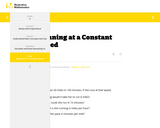
For this task, students explore reasoning with equivalent ratios and unit rates from both sides of the ratio to solve a problem.
- Subject:
- Mathematics
- Material Type:
- Activity/Lab
- Provider:
- Illustrative Mathematics
- Date Added:
- 02/28/2017

For this task, students explore reasoning with equivalent ratios and unit rates from both sides of the ratio to solve a problem.

This parent guide supports parents in helping their child at home with the 6th grade Math content.

This resource accompanies our Rethink 6th Grade Math course. It includes ideas for use, ways to support exceptional children, ways to extend learning, digital resources and tools, tips for supporting English Language Learners and students with visual and hearing impairments. There are also ideas for offline learning.
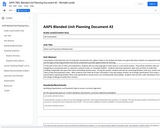
In this part of the unit on ratios and proportions, students will use ratio language to write ratios in a real-world context. They will be architects who are designing an amusement park, an aquarium research center, or a baseball stadium. Students will write equivalent ratios and use them to make their building a physically safe space that meets all building requirements. During this project, students will also be converting between units (e.g., inches and feet) as they find equivalent ratios. After students have made all of their calculations, they will analyze another set of design specifications and create a presentation explaining whether these new specifications would result in an architecturally safe building. Students will use their math calculations from the design challenge to justify their answers.
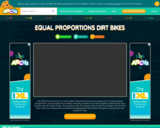
Dirt Bike Proportions is a multi-player kids educational racing game for finding equal proportions. How quickly the student correctly answers the ratio problem determines how quickly the dirt bike will go. The student with the fastest rate of correct answers will win the race. Hits and misses are recorded and displayed at the end of the game, along with the student's rate.
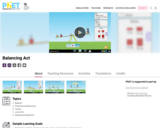
Sample Learning Goals
Predict how objects of various masses can be used to make a plank balance.
Predict how changing the positions of the masses on the plank will affect the motion of the plank.
Write rules to predict which way a plank will tilt when objects are placed on it.
Use your rules to solve puzzles about balancing.
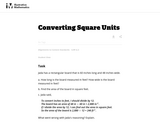
This task provides an opportunity to work on the Standard for Mathematical Practice 3 Construct Viable Arguments and Critique the Reasoning of Others.
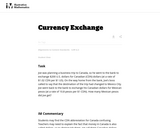
This task requires students to computer currency exchanges.
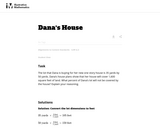
Students must convert yards to feet to solve this word problem.
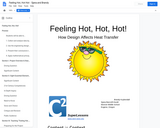
This project will be focused on designing, constructing and evaluating different containers to determine the optimal design for heat retention. After students have constructed their designs and collected and shared data, students will evaluate the class data to create an optimal design for our culminating event: warming ooey, gooey chocolate chip cookies to perfection! Through this activity, students will learn about energy transfer, engineering design process, data collection, graphing, rate of change, optimization, surface area and proportions. The students will test the effectiveness of their design using Vernier Probes to gather quantitative data and graphing the rate of temperature change. They will then create a poster presentation to share their data to the class. Students will use their mathematical skills to quantitatively analyze the strength and weaknesses of their designs while enjoying some delicious, toasty, warm cookies.

Students will be using unit rates of gas to see how it influences grocery prices. Students will have 2 days to create their own product to share with the class. This lesson was developed by Jodie Hott as part of their completion of the North Carolina Global Educator Digital Badge program. This lesson plan has been vetted at the local and state level for standards alignment, Global Education focus, and content accuracy.

Students will investigate why gas is so expensive or inexpensive in certain places. Students will look into alternative transportation modes that are used in the world. This lesson was developed by Jodie Hott as part of their completion of the North Carolina Global Educator Digital Badge program. This lesson plan has been vetted at the local and state level for standards alignment, Global Education focus, and content accuracy.

Students will be researching factors that impact gas prices, including the production and consumption of petroleum across the globe. Students will create a poster about transportation. This lesson was developed by Jodie Hott as part of their completion of the North Carolina Global Educator Digital Badge program. This lesson plan has been vetted at the local and state level for standards alignment, Global Education focus, and content accuracy.

Students will investigate gas price unit rates around the world. They will solve real world problems as well that include unit rates. This lesson was developed by Jodie Hott as part of their completion of the North Carolina Global Educator Digital Badge program. This lesson plan has been vetted at the local and state level for standards alignment, Global Education focus, and content accuracy.

This unit is for an EC pull-put sixth grade math class. Students will represent the same value as a fraction, decimal, and percentage as they label each continent on a map with the percentage of the world's population in each continent, based on information from the book, "If the World Were a Village." Students will discuss the distribution of populations around the globe and how that impacts those areas of the world differently.This lesson was developed by Virginia Campbell as part of their completion of the North Carolina Global Educator Digital Badge program. This lesson plan has been vetted at the local and state level for standards alignment, Global Education focus, and content accuracy.

This unit is for an EC pull-put sixth grade math class. Students have a discussion connecting their lives to the globe. They then discuss the concept of scale as it relates to maps/globes and the book "If the World Were a Village." Finally they use a graphic organizer to predict what the book is going to tell them about the people of the world.This lesson was developed by Virginia Campbell as part of their completion of the North Carolina Global Educator Digital Badge program. This lesson plan has been vetted at the local and state level for standards alignment, Global Education focus, and content accuracy.

This unit is for an EC pull-put sixth grade math class. Students present their poster projects to the class, and then write a reflection responding to the unit.This lesson was developed by Virginia Campbell as part of their completion of the North Carolina Global Educator Digital Badge program. This lesson plan has been vetted at the local and state level for standards alignment, Global Education focus, and content accuracy.

This unit is for an EC pull-put sixth grade math class. Teacher will model how to create a pie chart using data from the book, "If the World Were a Village." Then the class will create a pie chart together as guided practice. The class will draw conclusions about peoples' different experiences and perspectives from the data in the chart. The teacher will introduce the poster project to the students, and they will select a set of data from the book to create their own pie chart with. This lesson was developed by Virginia Campbell as part of their completion of the North Carolina Global Educator Digital Badge program. This lesson plan has been vetted at the local and state level for standards alignment, Global Education focus, and content accuracy.

This unit is for an EC pull-put sixth grade math class. In this lesson students create a pie chart from their chosen set of data and work on the other elements of the poster project, including interpreting and explaining the data.This lesson was developed by Virginia Campbell as part of their completion of the North Carolina Global Educator Digital Badge program. This lesson plan has been vetted at the local and state level for standards alignment, Global Education focus, and content accuracy.

Students will learn how many people in their community are classified as "food insecure" and what efforts are in place to help those people. Students will explore food wastage as an issue in the United States and will work with other members of the school and surrounding community to collect fruit or other items that would otherwise be wasted in the school cafeteria. Students will collect data about how much food is collected and then use proportions to determine how much food could be saved statewide if all schools participated for a whole school year.This lesson was developed by Rebecca Blanchard as part of their completion of the North Carolina Global Educator Digital Badge program. This lesson plan has been vetted at the local and state level for standards alignment, Global Education focus, and content accuracy.